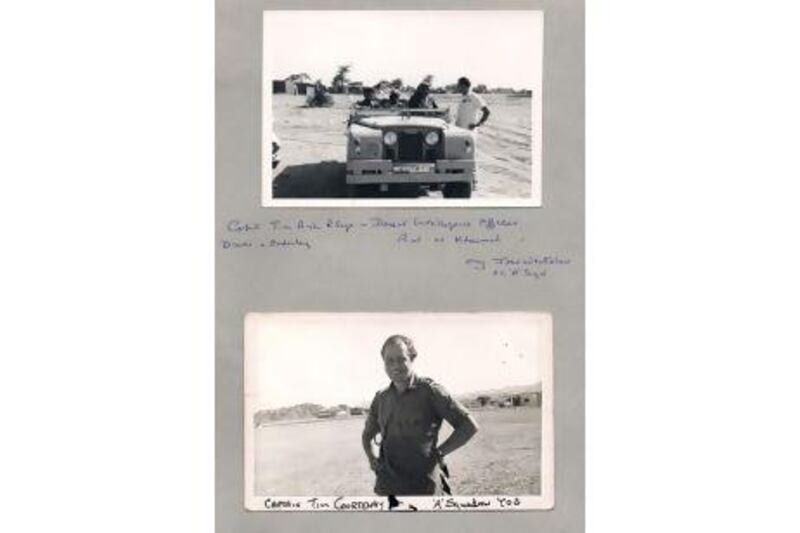ABU DHABI // Lt Col Tim Courtenay finished his three years of service in the Trucial States in 1970 and took home a prized possession: a print of Al Jahili Fort.
This week, he has returned with his print of the painting by the renowned British artist David Shepherd.
Lt Col Courtenay is one of 60 former Trucial Oman Scouts (TOS) visiting as guests of the Armed Forces for a tour of the country they helped to build.
It is a belated 60th anniversary for the British men who served here until the TOS became the Union Defence Force in 1971.
For some, it is the first time they have been back since being posted here in the early 1960s.
While preparing for the visit, Lt Col Courtenay knew he had to present his hosts with a gift to match the hospitality he received as a 27-year-old seconded officer.
"The most important part of the return was the gifts," he says.
The perfect present was hanging on a wall at his home: the print autographed 42 years earlier by the founding President Sheikh Zayed, the current President Sheikh Khalifa, Sheikh Tahnoon bin Mohammed Al Nahyan, then head of the Al Ain Municipality, and Sheikh Faisal bin Sultan Al Qasimi, who was also a scout.
Lt Col Courtenay contacted the artist, who added his signature and gave his blessing for 10 copies to be made.
The painting depicts Jahili Fort in all its splendour, with a Land Rover parked below its famous white tower and scouts atop lanky camels in the foreground.
The fort, a former summer residence of Sheikh Zayed, was given to the scouts after the 1955 Buraimi Incident that led to the Saudis ending their occupation and recognising Oman and UAE jurisdiction in the oasis.
The fort became the scouts' home in Al Ain.
"The great white fort was ours," says Lt Col Courtenay. "It says everything about soldiering in this part of the world."
As an officer, he had the privilege of staying in the fort's round tower. Soldiers lived in its walls. Before this, they lived in barasti huts.
"It was our home," says Lt Col Courtenay. "I lived in the room at the top. If you've ever tried to furnish a round room, it's quite difficult."
From this base, the scouts made desert patrols by camel and Land Rover into the far west to secure the borders, unite the tribes through coffee-pot diplomacy, and stop bandits, slave traders and the spread of polio.
It was a time Lt Col Courtenay refers to as "Biblical days".
Like the nameless men in the print, he made camel patrols, one atop a beast called Sulayman.
"He was rather smelly and had very bad breath, but nonetheless camel patrolling was an important aspect of our continuation of the TOS," Lt Col Courtenay says.
The original painting was hung in the officers' mess and prints were available for scouts who lived there. His print disappeared into the desert for six months when he asked a friend to have Sheikh Zayed sign it.
It was returned just days before Lt Col Courtenay's redeployment to the UK. The print was "a bit creased and slightly stained but alhumdullilah, it is signed by His Highness Sheikh Zayed".
The other signatures were a pleasant surprise.
Now the prints have returned with the scouts. One copy will go to the British Ambassador and two of the signatories, Sheikh Khalifa and Sheikh Tahnoon, will each receive one.
Another gift includes 25 years of personal photographs by TOS members in a leather-bound book compiled by the former scout Hugh Nicklin.
"I like to think that perhaps living the way we did and controlling all sorts of problems that existed not only between the various sheikhs - like smuggling, arguments over gardens, arguments over water wells - that we brought peace and serenity into the area," says Michael Curtis, a TOS captain.
Sergeant Major Atiq Murad Al Baloushi was an adolescent when he joined the TOS. His facial hair had yet to grow but he still remembers the date he became a solider: 27 Feb 1957.
"I eat from work, how could I forget this date?" said Sgt Major Al Baloushi. "The rulers of the emirates wanted to create an army, they wanted nationals. The British came and served and protected the country in coordination with the rulers. They trained the people of the emirates."
The scouts and prints have toured the country since their arrival this week.
On Monday they paid their respects at British war graves in Sharjah; on Tuesday they visited their old camp in Ras Al Khaimah and had the honour of a camel patrol by Emirati soldiers; and on Thursday they visited Jahili Fort.
For the British scouts, success rested on the friendships forged by working, living and eating side by side with soldiers from all backgrounds.
While many scouts arrived in their teens, most are now in their 70s and 80s. Lt Col Courtenay calls the reunion "the last hurrah".
"Of course, it won't be the final farewell," he says.
For a video interview of Lt Col Tim Courtenay, visit thenational.ae/multimedia
Michael Curtis, who was second in command of A Squadron and a Jahili Fort resident in his time with the TOS, will speak at the Emirates Airline Festival of Literature at 4.30pm tomorrow at the InterContinental hotel, Dubai about his book, Arabian Days (co-authored with Col Antony Cawston).






